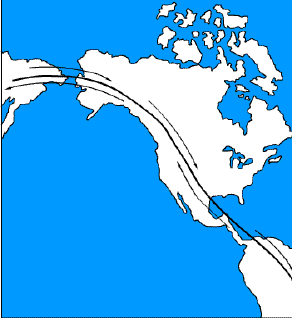|
Natives and Foreigners

Early migration routes show how animals could have
traveled between Asia and North America when a land bridge connected
the two continents. It is also certain that animals moved
between the two Americas. The camel migrated from Western
Hemisphere to the Eastern Hemisphere. Elephant, reindeer,
bison, musk-ox, bear, and sheep passed from the Eastern Hemisphere
to the Western Hemisphere. |
Where did the Irvington land mammals originate? Only a partial answer is
possible at the present time, but paleontological “detectives” are turning
up fresh clues almost daily. Amateurs have uncovered fossilized bones of
thirteen natives, six “foreigners” (three from South America and three from
Asia), and four mammals whose origins remain in doubt. (see chart below)
How did they get here? There are many perplexing questions about the
dispersal of animals. Here are some examples:
Might certain changes in the abiotic environment cause animals to migrate
changes such as drying up of swamplands, invading seas, rising mountain ranges,
too much or too little rainfall, long term change in temperature range, or
shifting ocean currents? (It is known that Pleistocene animals retreated from
advancing ice fronts, or glacier, and followed retreating ice fronts.)
Might biotic influences cause animals to migrate for
example, disappearance of essential producers, an increase in the number of
first-order consumers and second-order consumers, diseases caused by
microorganisms, or breaks in the food chain?
Today a water barrier (Bering Strait) prevents over lands migration from
Asia to North America. Migrations took place in the past, however, when the area
now submerged was dry land. Such land migration routes are usually called land
bridges. This one was evidently a two-way bridge; remains of North America
mammals have been found in Asia.
Land mammals of the Western Hemisphere were separated for millions of
years by a water barrier between North and South America. As ocean waters began
to recede, higher points of land became islands, with animals beginning their
migration from one continent to another by island hopping. (Many kinds of
animals, including mammals, cling to pieces of driftwood, which may then float
them from one island to another.) Eventually the sea retreated (or the land
rose) to from the existing land bridges, Central America. Such bridges rose,
“fell”, and rose again more than once, especially the one between Asia and
North America.
|
Origin |
Mammal Age |
|
Old World or North America |
Asia |
South America |
North America |
|
Odocoileus
(deer) |
|
|
|
Blancan |
Dinobastis
(sabercat) |
|
|
|
Irvingtonian |
Arctodus
(bear) |
|
|
|
Irvingtonian |
Microtus
(vole) |
|
|
|
Irvingtonian |
| |
Smilodan
(sabercat) |
|
|
Irvingtonian |
| |
Mammuthus
(mammoth) |
|
|
Irvingtonian |
| |
Mammut
(mastodon) |
|
|
Barstovian |
| |
|
Paramylodon
(ground sloth) |
|
Late Blancan |
| |
|
Platygonus
(peccary) |
|
Blancan |
| |
|
Megalonyx
(ground sloth) |
|
Hemphillian |
| |
|
|
Neotoma
(wood rat) |
Irvingtonian |
| |
|
|
Thomomys
(pocket gopher) |
Irvingtonian |
| |
|
|
Sylvilagus
(cottontail rabbit) |
Irvingtonian |
| |
|
|
Canis (wolf) |
Hemphillian |
| |
|
|
dirus (wolf) |
Irvingtonian |
| |
|
|
irvingtonensis
(coyote) |
Irvingtonian |
| |
|
|
Euceratherium
(oxlike animal) |
Irvingtonian |
| |
|
|
Camelops (Camel) |
Late Blancan |
| |
|
|
Tetrameryx
(antelope) |
Blancan |
| |
|
|
Equus (horse) |
Early Blancan |
| |
|
|
Taxidea (badger) |
Early Blancan |
| |
|
|
Tanupolama (camel) |
Hemphillian |
| |
|
|
Citellus
(Ground Squirrel) |
Barstovian |
| |
|
|
Perognathus
(pocket mouse) |
Barstovian |
| |
|
|
Peromyscus
(white-footed mouse) |
Barstovian |
|